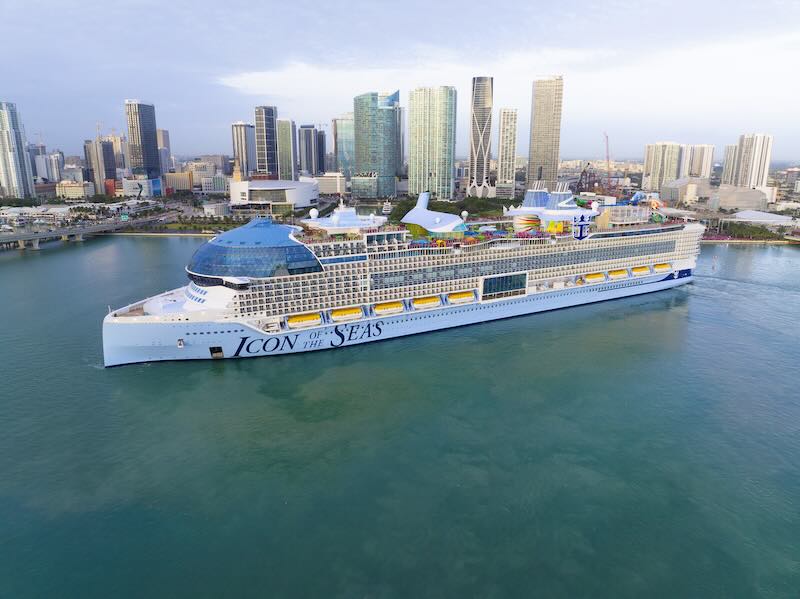In recent years, the cruise industry has seen ships getting bigger and more extravagant with each new launch. These floating cities, packed with everything from water parks to Broadway-style theaters, have become the norm. But now, with Royal Caribbean reportedly considering a new class of smaller ships, it’s worth asking: Have cruise ships gotten too big for their own good?
The Rise of the Mega-Ship
Let’s rewind a bit. The trend of building ever-larger ships really took off in the late 20th century, and it hasn’t slowed down since. Cruise lines like Royal Caribbean have been at the forefront of this movement, rolling out massive vessels like the 7,600 passenger Icon of the Seas, the world’s largest cruise ship and her sister, Star of the Seas arriving in 2025.
These ships are more than just a way to get from point A to point B—they’re destinations in themselves. Passengers can spend days without ever leaving the ship, enjoying everything from zip lines to ice-skating rinks to countless dining options. For many, the ship is the vacation, and the ports of call are just a bonus.

Why Bigger Seemed Better
So, why did cruise lines go big in the first place? For one, it’s all about economies of scale. A larger ship can spread out its costs over more passengers, making cruises more affordable while still offering tons of amenities. These mega-ships are designed to cater to a wide range of interests and age groups, so whether you’re a family with young kids or a couple looking for a romantic getaway, there’s something for you onboard.
Plus, the sheer variety of activities available means that passengers can have totally different experiences on the same ship. One family might be hitting up the water slides all day, while another couple might spend their time lounging by the pool and enjoying gourmet meals. Bigger ships offer more choices, plain and simple.

The Downside of All That Size
But let’s be real—bigger isn’t always better. One of the biggest complaints about these mega-ships is the crowd factor. Even though these ships are designed to handle thousands of passengers, all those people in one place can mean long lines, packed pools, and a general lack of personal space. Not exactly the relaxing vacation you might have had in mind.
Then there’s the environmental impact. Larger ships naturally consume more fuel and produce more waste, which isn’t great for the planet. And while the cruise industry has made some strides in going green, it’s still a challenge to run these giant vessels sustainably.
There’s also the issue of how these massive ships affect the places they visit. When thousands of passengers disembark at once, it can overwhelm smaller ports, leading to a less authentic experience. Some destinations are even starting to limit the number of large ships that can dock at the same time to protect their local environment and culture.
Big vs. Small: What’s the Better Experience?
Size also plays a big role in the overall vibe of a cruise. Mega-ships can feel a bit impersonal. With so many people onboard, it can be tough to find a quiet spot or really connect with fellow passengers.
On the flip side, smaller ships offer a completely different experience. They tend to focus more on personalized service and unique itineraries. Plus, they can dock at smaller, less touristy ports that the bigger ships can’t reach. If you’re the type of traveler who likes to explore off-the-beaten-path destinations and enjoy a more intimate setting, a smaller ship might be more your speed.
Take cruise lines like Azamara, for example. They operate smaller vessels that can navigate into places like Venice or secluded bays that the big guys can’t get into. This focus on immersive, destination-driven experiences is a far cry from the all-in-one vacation offered by the mega-ships.

Why Royal Caribbean Might Be Thinking Smaller
So, what’s behind Royal Caribbean’s possible shift to smaller ships? It could be a sign that the cruise industry is starting to rethink the bigger-is-better mantra. There’s definitely a growing demand for more sustainable, personalized travel experiences, and smaller ships fit that bill.
If Royal Caribbean does go smaller, it would be a pretty big deal. It might indicate that they’re trying to appeal to passengers who are looking for something a little different—maybe even people who’ve done the mega-ship thing and are now ready for a new kind of adventure.
Smaller ships might also be more appealing to seasoned cruisers who are looking for new destinations and a more tailored experience. After all, once you’ve been on a few big ships, you might start craving something a little more unique.
Finding the Sweet Spot: Could a Middle Ground Be the Answer?
Of course, the future of cruise ship design doesn’t have to be all about extremes. There’s probably a happy medium somewhere between the mega-ships and the smaller, more intimate vessels.
Imagine a ship that’s large enough to offer a variety of onboard activities but small enough to dock at exclusive ports and provide a more personalized service. That could be the sweet spot that satisfies both first-time cruisers and those looking for something different.
What’s Next for the Cruise Industry?
The trend of building bigger and bigger cruise ships has brought a lot of benefits, but it’s also raised some important questions about the future. With Royal Caribbean reportedly considering a move toward smaller ships, we might be seeing the start of a new trend in the industry—one that focuses more on balance and variety than just size.
Whether cruise ships have gotten too big really comes down to personal preference. Some people love the excitement and endless options of a mega-ship, while others prefer the charm and intimacy of a smaller vessel. As the cruise industry continues to evolve, it’ll be interesting to see how these different perspectives shape the future.
In the end, it’s not just about the size of the ship but the experience it offers. Cruise lines that can cater to a wide range of tastes and preferences are likely to thrive, no matter where the trend toward ship size heads. Whether you’re all about the big ships or ready to try something smaller, one thing’s for sure: there’s a cruise out there for everyone.
